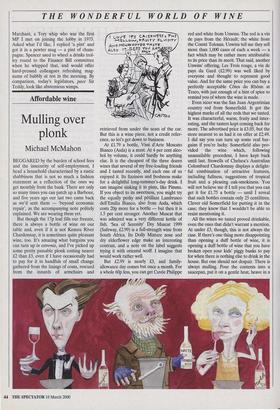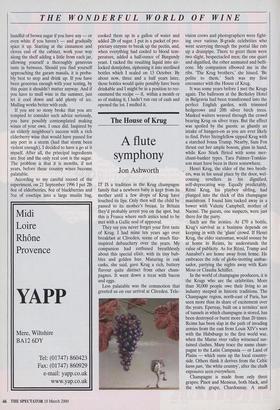Affordable wine
Mulling over plonk
Michael McMahon
BEGGARED by the burden of school fees and the insecurity of self-employment, I head a household characterised by a rustic shabbiness that is not so much a fashion statement as a reflection of the ones we get monthly from the bank. There are only so many times you can patch up a Barbour, and five years ago our last two came back as we'd sent them — 'beyond economic repair', as the accompanying note politely explained. We are wearing them yet.
But though the 17p loaf fills our freezer, there is always a bottle of wine on our table and, even if it is not Kemeu River Chardonnay, it is sometimes quite pleasant wine, too. It's amazing what bargains you can turn up in extremis, and I've picked up some pretty passable plonk costing nearer £2 than £3, even if I have occasionally had to pay for it in handfuls of small change gathered from the linings of coats, rescued from the innards of armchairs and retrieved from under the seats of the car. But this is a wine piece, not a credit refer- ence, so let's get down to business.
At £1.79 a bottle, Vissi d'Arte Moscato Bianco (Asda) is a must. At 4 per cent alco- hol by volume, it could hardly be anything else. It is the cheapest of the three dozen wines that several of my free-loading friends and I tasted recently, and each one of us enjoyed it. Its fizziness and freshness make for a delightful long-summer's-day drink. I can imagine sinking it in pints, like Pimms. If you object to its sweetness, you might try the equally perky and petillant Lambrusco dell'Emilia Bianco, also from Asda, which costs 20p more for a bottle — but then it is 1.5 per cent stronger. Another Muscat that was admired was a very different kettle of fish. 'Sea of Serenity' Dry Muscat 1999 (Safeway, £2.99) is a full-strength wine from South Africa. Its Dolly Mixture nose and dry elderflower edge make an interesting contrast, and a note on the label suggests trying it with oriental scoff. I imagine that would work rather well.
But £2.99 is nearly £3, and family- allowance day comes but once a month. For a whole 60p less, you can get Cuvee Philippe red and white from Unwins. The red is a vin de pays from the Herault; the white from the Comte Tolosan. Unwins tell me they sell more than 1,000 cases of each a week — a fact which may be rather more attributable to its price than its merit. That said, another Unwins' offering, Les Trois rouge, a vin de pays du Gard (£2.99) was well liked by everyone and thought to represent good value. And for the same price you can buy a perfectly acceptable Cotes du Rhone at Tesco, with just enough of a hint of spice to remind you of where the wine is made.
Even nicer was the San Juan Argentinian country red from Somerfield. It got the highest marks of all the reds that we tasted. It was characterful, warm, fruity and inter- esting, and the tasters kept coming back for more. The advertised price is £3.05, but the store nearest to us had it on offer at £2.49. I did say you can turn up some real bar- gains if you're lucky. Somerfield also pro- vided the wine which, following unassailable precedent, I have kept back until last. Stowells of Chelsea's Australian Colombard Chardonnay displays a delight- ful combination of attractive features, including fullness, suggestions of tropical fruit and a pleasing oak-smokiness. You will not believe me if I tell you that you can get it for £1.75 a bottle — until I reveal that such bottles contain only 25 centilitres. Clever old Somerfield for putting it in the case; they knew that I wouldn't be able to resist mentioning it.
All the wines we tasted proved drinkable, even the ones that didn't warrant a mention. At under £3, though, this is not always the case. If there's one thing more disappointing than opening a duff bottle of wine, it is opening a duff bottle of wine that you have broken open your kids' piggy banks to pay for when there is nothing else to drink in the house. But one should not despair. There is always mulling. Pour the contents into a saucepan, put it on a gentle heat, heave in a handful of brown sugar if you have any — or even white if you haven't — and gradually spice it up. Starting at the cinnamon and cloves end of the cabinet, work your way along the shelf adding a little from each jar, allowing yourself a thoroughly generous taste in between. Should you find yourself approaching the garam masala, it is proba- bly best to stop and drink up. If you have been generous enough with your testing, by this point it shouldn't matter anyway. And if you have to mull wine in the summer, just let it cool down and add plenty of ice. Mulling works better with reds.
If you are so stony broke that you are tempted to consider such advice seriously, you have possibly contemplated making wines of your own. I once did. Inspired by an elderly neighbour's success with a rich elderberry wine that would have passed for any port in a storm (had that storm been violent enough), I decided to have a go at it myself. After all, the principal ingredients are free and the only real cost is the sugar. The problem is that it is months, if not years, before these country wines become palatable.
According to my careful record of the experiment, on 21 September 1996 I put 21b 8oz of elderberries, 8oz of blackberries and 5oz of rosehips into a large muslin bag, cooked them up in a gallon of water and added 21b of sugar. I put in a packet of pro- prietary enzyme to break up the pectin, and, when everything had cooled to blood tem- perature, added a half-ounce of Burgundy yeast. I racked the resulting liquid into air- locked demijohns, siphoning it into sterilised bottles which I sealed on 13 October. By about now, three and a half years later, those bottles would quite possibly have been drinkable and I might be in a position to rec- ommend the recipe — if, within a month or so of making it, I hadn't run out of cash and opened the lot. I mulled it.



















































































 Previous page
Previous page